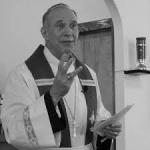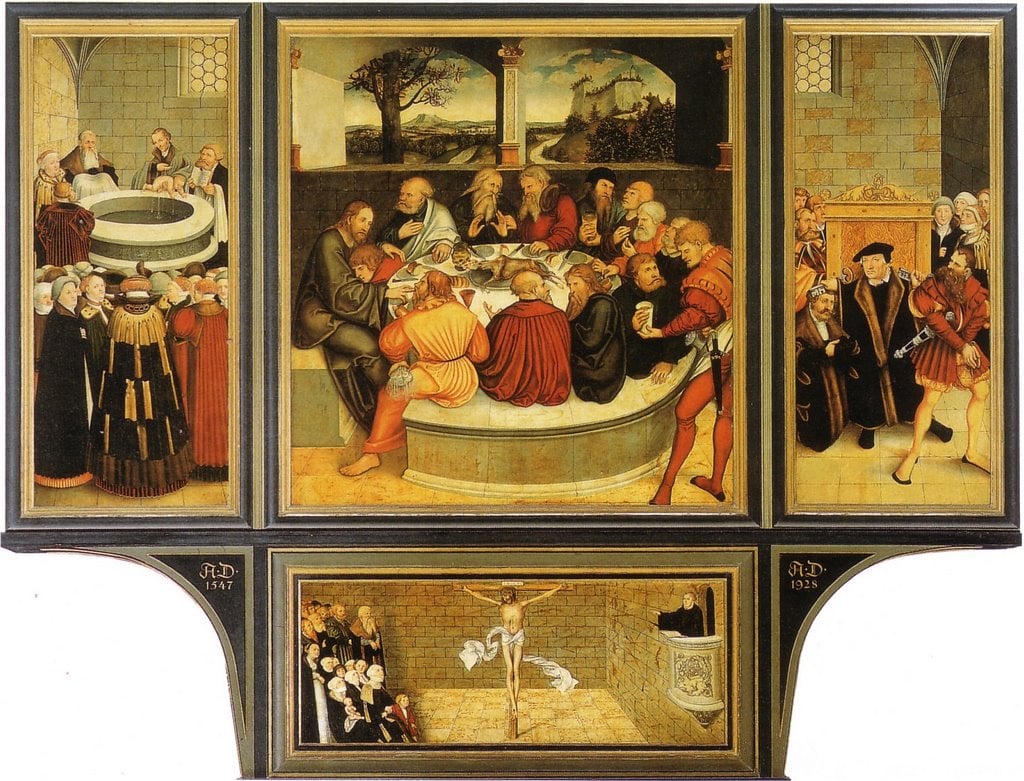After Calvin published his Institutes as well as his several treatises on the Lord ’s Supper, many Lutherans quickly rose up to begin writing in defense of the doctrine which they held so sacred. This time however, they were not writing against someone who gave barely any importance to the sacrament but one who fought for its sacredness.
The two main exegetical issues in this debate were the words of institution and the issue of whether or not Christ’s human body was communicated omnipresence. First of all, some issues needed to be cleared up in regards to common misunderstandings of the Lutheran view of the Eucharist. First of all, the charge was often brought and continues to be against the Lutheran church that they teach “consubstantiation.” The word in itself is not necessarily problematic, and a few Lutheran dogmatists have used it. However, along with the word comes great misunderstanding. There was an older position in the medieval church which was called “consubstantiation” or “impanation” to where the physical body of Jesus was implanted within the elements of bread and wine. The problem with this is that it explains too much. The Lutheran church has never tried to explain how the whole Jesus is present in bread and wine, but that he is. The words “in, with, and under” commonly used in Lutheran theology are simply ways to try to get across the idea that somehow Jesus is there when the recipient receives the Eucharist.
Another important thing that needs to be discussed is that the Lutheran church does not believe in the necessary or local omnipresence of the body of Christ. Christ in his human nature is not omnipresent in and of itself, for that would destroy his humanity. However, due to the unified person of Christ, the attributes of the divine nature are communicated to the human nature. It is by gift, not by nature. Also, Christ’s body is not locally present in all places. In other words, there are different modes of presence. The body of Christ was on earth before the ascension in a local manner which is different from the manner in which he was present afterwards. As Jesus himself testifies, “And surely I am with you always, to the very end of the age.” The Lutheran divines saw this statement as showing that Jesus, while he would not be present in the same manner he was with the disciples, would be present with his church for all time. The question now to be asked is if this is only according to his divine nature that he is present or according to both natures. Exegetically the second option is preferable.
If the divine nature is present everywhere, while the human nature is present only at the right hand of the Father, then most of the person of Jesus is without his human nature. This means that only a small part of his divinity had become incarnate. It was the Lutheran contention that if Jesus was truly incarnate, it was all of Jesus, thus wherever he is, there is both his human and divine nature. Is this taught anywhere directly in scripture? Observe Paul’s statement in Ephesians 4, “He who descended is the very one who ascended higher than all the heavens, in order to fill the whole universe” This speaks of Christ’s ascension to fill the whole universe. If this were merely about his divine nature, then one would have to admit that Paul believes Christ to have been omnipresent in his divine nature only after the incarnation. Since this destroys his deity, it is untenable. Thus, Paul must be referring to Christ in his human nature. The reformed position must force its own theology into the text. When Matthew wrote that Jesus was to be with the church always, is there any evidence that he was thinking of the divinity of Christ apart from his humanity? It is nowhere in the text.
This is further proven by the fact that Christ is said many times in scripture to gain attributes of deity in time. As God of course, he already had these attributes. Thus, they must have been given in time to his human nature. For example in Philippians 2, Paul speaks of Christ gaining a name that is above every name by his death on the cross, not by nature. He was exalted because of his obedience. Jesus in John 3:35 is said to have been given all things by the father. Parallel expressions are found in Matthew 11:27, and Luke 10:22. If he has truly been given all things then he is according to his whole person omnipotent. This cannot refer to his divine nature unless one resorts to subordinationism. As American Lutheran theologian Charles Krauth says, “Christ, then, has received according to one nature, to wit, the human, what He intrinsically possessed in the other, to wit, in the divine, or, as it has been expressed, Whatever Christ has in the one nature by essence, He partakes of in the other by grace- and this is the doctrine of our Church.” Jesus is seen in the gospels to disappear at times, and even to walk through walls. These are attributes, not of humanity but of deity. They must have been communicated to the human nature. Jesus confessed before his disciples, “All authority in heaven and on earth has been given to me”. The man Jesus said this to his disciples. There is no reason to believe this refers to his divine nature alone. This interpretation is not a new one with the emergence of Protestantism but was taught by several highly esteemed fathers of the church. Athanasius says, “Whatever the scripture declares that Christ had received in time, it affirms with reference to his humanity, not with reference to his deity.” The book of Concord contains an appendix with several quotes of Patristic sources showing this to be a historic teaching.
The reformed argue that when scripture declares that Christ is seated at the right hand of the father he must be present nowhere else according to his human nature. It was argued by Chemnits, Luther, Melancthon and others that this statement was one of status rather than locality. Christ’s being seated at God’s right hand is a statement of his authority. Does God have a literal body on a throne he sits on with Christ sitting beside Him? This is an absurd thought.
Now that it is has been shown that scripture allows for and in fact teaches the omnipresence of the whole Christ, the question to be asked is if he is specially present within the supper. The words of institution are some of the most debated words of the New Testament. When Jesus says “this is my body”, what does he mean? Luther’s one time pupil, Andreas Carlstadt argued that when Jesus said these words he was pointing to his literal body, not to the bread. This interpretation was foolish and abandoned quickly. The reformed and Anabaptists tried to argue that these words of Jesus were merely symbolic. Which word in the phrase “this is my body” is a symbol? It was argued by some that the word body was symbolic. However, this would deny that the following phrase “broken for you” referred to his actual bodily crucifixion. This interpretation had also been largely abandoned.
The majority Reformed position on Jesus words were that Jesus was using the word “is” to mean “represent.” Jesus was saying to the disciples, “this represents my body.” Lutheran theologians argued that there was no reason to take these words in a non-literal fashion. Did Jesus ever use this type of language symbolically in other circumstances? It was argued that when Jesus says things such as “I am the vine” he is using a similar figure of speech. Is Jesus literally a vine? No, of course he is not. However, that does not mean that these two statements are parallel. Note than in the second saying, it is not the word “is” that is symbolic. Rather it is the word “vine.” Jesus really is the vine. The question is, what does vine mean? No statement of Jesus in the gospels necessitates a symbolic understanding of the word is. Even if it could be argued that it is a possibility that the word could be used in such a way as to mean represents, the burden of proof would lay on the Reformed side. It needs to be shown that the word need not be used in its usual sense.
It is also argued against the Lutheran doctrine that if Jesus means that the bread literally is his body, then it would support a doctrine of transubstantiation rather than sacramental union. For the Lutheran doctrine to be true, Jesus must have meant “my body is in, with and under this bread.” However, it is not the case that for Jesus to admit that his body is present, it would deny that the bread is also present. It is a common figure of speech to, for example, hold a glass filled with water and say “this is water.” It would not be in any way denying the fact that the glass was present as well. No one would argue that it must mean that I was stating my entire glass was transubstantiated into water. The argument simply does not account for the way speech works.
There is one other passage which is widely debated between both theological positions. This is 1 Corinthians 10:16, “Is not the cup of thanksgiving for which we give thanks a participation in the blood of Christ? And is not the bread that we break a participation in the body of Christ?” It is clear in this verse that through the wine, we are participating in his actual blood, and through the bread, his body. It has been urged by some, including Zwingli, that the body refers not to God’s actual body but to the church. This interpretation makes some sense, however what about the previous statement about participating in the blood of Christ? Zwingli argued that this also was a reference to the church since the church was identified by and covered by the blood of Christ. However, there is no reference in the New Testament or early church writings which calls the church “the blood of Christ.”
Calvin saw that Zwingli was flawed. This is why he believed in an actual participation of his body and blood. However, Calvin was already committed to the idea that Christ’s human nature could not be omnipresent. Thus, he developed a new formula which involved the Spirit causing the soul to ascend to heaven. Lutheran theologians argued against this proposition in three ways. First of all, the Bible simply does not mention any such action. The Spirit is not ever spoken of as being an instrument in bringing us Christ through the supper. If it is not exegetically supportable, it should not be accepted. Secondly, the idea of us ascending to God is contrary to the message of the New Testament. The gospel is about Christ descending to save us. Thus, the supper as a visible form of the gospel, unless otherwise stated in Scripture, should be seen to work the same way. Thirdly, this idea is based upon the assumption that Christ cannot be present in his human nature in more than one place. This has already been shown to be unproven.
The final attack of the Lutheran dogmatists against the Calvinistic theory of the Eucharist is that the Calvinists believe that Christ is present only by faith. There is no presence of Christ for the unbeliever. Much of the argument came from John 6:63 which says, “the Spirit gives life, the flesh counts for nothing.” How can Jesus’ life giving bread be given to those who are in the flesh? For this verse to have any bearing upon the discussion, it must be shown that this chapter is about the Eucharist. If this chapter is shown to be about the Eucharist, it contains several statements which prove the Lutheran doctrine of the presence of Christ’s human nature. “For my flesh is real food and my blood is real drink.” Paul’s words in 1 Corinthians point to the fact that unbelievers do partake of Christ’s body and blood, but rather than unto life, unto judgement. “Therefore whoever eats the bread or drinks the cup of the Lord in an unworthy manner will be guilty of sinning against the body and blood of the Lord.” Paul sees those who partake unworthily of sinning against the actual body and blood of the Lord, not of a symbol. This offense was so serious that God killed members of the congregation for doing so.
Calvin’s position, as a compromise corrected several of the errors in Zwingli’s exegesis. However, he still held to assumptions that controlled his reading of the crucial passages of the text, not allowing them to speak for themselves. Luther was justified in not accepting Zwingli’s hand of fellowship.















